Frigate Augsburg F222

Reviewed April 2016
by Martin J Quinn

Reviewed April 2016
by Martin J Quinn
| HISTORY | |||||||||||||
|
The F120, or Köln, class
is a class of six frigates built for the German Navy. These were
the first major warships built in Germany after World War II.
The class entered service over a three-year period between 1961 and 1964.
All were decommissioned by 1989, several being sold to Turkey. The
ships were replaced by the eight ship Bremen-class, which are now in the
process of being retired and replaced as well.
For more on the class, see
the Wikipedia article here.
Photo top of page, Wikipedia Finland.
|
|||||||||||||
| The
NNT Fregatte Augsburgh
The Augsburg comes in NNT's familiar sturdy white cardboard box, with a photo of the ship on the box top, in lieu of artwork. Upon opening the box, you’ll find a one-piece resin
hull with the majority of the superstructure cast in place. There are also
six small resin ‘trees’ and one resin wafer. There are also 3 sheets of
instructions included (two sheets are the identical – one is in English
and one is in German) and two small decal sheets.
|
|||||||||||||
| THE HULL | |||||||||||||
| The hull is marvelously cast in a buttery yellow resin. It’s crisp and clean with lots of detail. It also scales out pretty much perfectly in length and beam. The bollards and other bits, breakwater and depth-charge racks are distinct and well-cast, the splinter shielding is very thin to the point of being transparent. There is a slight hint of over pour on the bottom of the hull – some light sanding or putting the hull in a seascape will take care of that. | |||||||||||||
|
|
|||||||||||||
| SUPERSTRUCTURE PARTS/MAIN BATTERY TURRETS/GUN MOUNTS | |||||||||||||
| The superstructure parts and main battery turrets are on a thin resin wafer, and will need to be sanded off. The bases for the 40mm guns are also included here, as are what appear to be life raft canisters. Everything is well cast. The turrets are crisp with sharp edges. | |||||||||||||
|
|
|||||||||||||
| REMAINING SMALL PARTS | |||||||||||||
| I’ll label the rest of the parts
“ small parts”, as there is nothing to identify them in the instructions.
These parts - which are all on resin runners - appear to be secondary weapons,
torpedo tubes, searchlights, masts, antennas, gun tubs, more life raft
canisters, some bridge equipment and a cutter.
All the small parts are crisply cast, with little flash found on my sample. |
|||||||||||||
|
|
|||||||||||||
| PHOTO-ETCH | |||||||||||||
| There is a small photo-etch set included with the model. There are anchors, prop guards, a reverse funnel cap, radars and parts for the main mast. The photo-etching is nicely done, but there is no apparent relief etching. There are also no railings in the kit, which I will put down as a ding. For a kit that lists for 58,00 Euros, railings should be included, in my opinion. | |||||||||||||
|
|||||||||||||
| DECALS | |||||||||||||
| There are two small decal sheets included. The odd thing is that they are similar, but different. One is larger than the other, and includes pennant numbers for all the ships in the class. Also, there is no indication in the instructions where any of these – other than the main pennant numbers – are placed. The decals do appear to be a bit thick – make sure you put a good gloss coat down on the model and have some setting solution handy to make them settle down. | |||||||||||||
|
|||||||||||||
| INSTRUCTIONS | |||||||||||||
| As mentioned earlier, the instructions
are three sheets of paper. Two are identical, just in two different languages
(English and German). This sheet has the particulars of the ships (dimensions,
where they she was built, etc) on one side. The other side has a plan and
profile view of the ship, with a list of colors and what appear to be either
Humbrol or Revell of Germany paint equivalents.
The other sheet has photos of the hull and resin parts on one side. Oddly, part numbers 23, 24 and 25 are used twice, and for completely different parts. Use caution when building and make sure you are using the right part 23, and so on, as each duplicate number appears on the instructions. The second side of this sheet shows two photos of the completed model, one of the starboard side and one of the port side. Around the model are squares with numbers (resin parts) and circles with numbers (photo-etch parts) and lines pointing to where they go on the model. Now, most modelers should be able to figure this all out, but it’s a pet-peeve of mine that directions for resin ships (in general) seem to be lacking. There is no sequence of instructions, you have to figure that out on your own. Again, I think that is a short coming in many resin kits, including this one. |
|||||||||||||
|
|||||||||||||
| CONCLUSIONS | |||||||||||||
| I have two nit-picks
about the kit: the instructions are a little lacking, and the photo-etch
doesn’t include railings. Those aside, the NNT Fregatte Augsburg is a sweet
little kit. It’s very well cast with a nice set of photo-etch (except the
railings!) that has the potential to build into a great little model. As
this is an in-box review, your mileage may vary once construction commences.
Highly Recommended to fans of Post-World War II ships.
The Augsburg is available for €58,00 directly from NNT Modell, who I’d like to thank for this review sample. |
|||||||||||||
